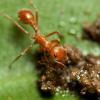- Formiculture.com
- Forums
- Gallery
- Members
- Member Map
- Chat

Can Ants Change color as the colony grows?
Started By
Aaron567
, Nov 9 2016 1:43 PM
7 replies to this topic
#1
 Offline
-
Posted November 9 2016 - 1:43 PM
Offline
-
Posted November 9 2016 - 1:43 PM
I have a 6 worker (All nanitics) colony of Dorymyrmex, and I'm not entirely sure what species they are, but I've been thinking D. bureni. The problem is, they are a very different color from bureni. The D. bureni in my backyard are a yellow/orange color, while mine are a weird gray/brown. I've also seen only small colonies of these gray/brown Dorymyrmex workers in the wild.
This past summer, I've seen the female alates from the Dorymyrmex bureni nests in my yard and they look exactly like the queen I have.
Is it possible for the workers to change color as the colony gets larger?
I can provide pictures if needed.
This past summer, I've seen the female alates from the Dorymyrmex bureni nests in my yard and they look exactly like the queen I have.
Is it possible for the workers to change color as the colony gets larger?
I can provide pictures if needed.
#2
 Offline
-
Posted November 9 2016 - 1:55 PM
Offline
-
Posted November 9 2016 - 1:55 PM
Ants that are young may not have their full colour yet, sometimes due to the exoskeleton not being fully hardened. Also same species from different localities, or even just different specimens may have different colours. But the colour difference you are describing might either be "not full colour yet" as explained above or a different species entirely. I'm not sure on Dorymyrmex since I don't have them here, that's just generally what I know about ants and their colours.
- Solenoqueen likes this
#3
 Offline
-
Posted November 9 2016 - 2:49 PM
Offline
-
Posted November 9 2016 - 2:49 PM
Ants that are young may not have their full colour yet, sometimes due to the exoskeleton not being fully hardened. Also same species from different localities, or even just different specimens may have different colours. But the colour difference you are describing might either be "not full colour yet" as explained above or a different species entirely. I'm not sure on Dorymyrmex since I don't have them here, that's just generally what I know about ants and their colours.
Yes, if the ants are one color and they change later, they're just hardening from their emergence from the pupal stage. If your nanitics are still that way, you have a very new colony. Also, ants of some species, maybe Doromyrmex have color morphs, kind of like tiger centipedes that could be blue or orange. Same with some weaver ants that could be green or red, and Doromyrmex, that could be orange or gray. Answer you question, mate? Good day to you.
Edited by Solenoqueen, November 9 2016 - 2:50 PM.
:>
#4
 Offline
-
Posted November 9 2016 - 3:31 PM
Offline
-
Posted November 9 2016 - 3:31 PM
Yes, if the ants are one color and they change later, they're just hardening from their emergence from the pupal stage. If your nanitics are still that way, you have a very new colony. Also, ants of some species, maybe Doromyrmex have color morphs, kind of like tiger centipedes that could be blue or orange. Same with some weaver ants that could be green or red, and Doromyrmex, that could be orange or gray. Answer you question, mate? Good day to you.Ants that are young may not have their full colour yet, sometimes due to the exoskeleton not being fully hardened. Also same species from different localities, or even just different specimens may have different colours. But the colour difference you are describing might either be "not full colour yet" as explained above or a different species entirely. I'm not sure on Dorymyrmex since I don't have them here, that's just generally what I know about ants and their colours.
The nanitics exoskeleton have completely hardened. Some of them are several weeks old. I know there can be different color morphs, but I don't ever see a large colony of these grayish colored ones.
#5
 Offline
-
Posted November 9 2016 - 3:56 PM
Offline
-
Posted November 9 2016 - 3:56 PM
Yes, if the ants are one color and they change later, they're just hardening from their emergence from the pupal stage. If your nanitics are still that way, you have a very new colony. Also, ants of some species, maybe Doromyrmex have color morphs, kind of like tiger centipedes that could be blue or orange. Same with some weaver ants that could be green or red, and Doromyrmex, that could be orange or gray. Answer you question, mate? Good day to you.Ants that are young may not have their full colour yet, sometimes due to the exoskeleton not being fully hardened. Also same species from different localities, or even just different specimens may have different colours. But the colour difference you are describing might either be "not full colour yet" as explained above or a different species entirely. I'm not sure on Dorymyrmex since I don't have them here, that's just generally what I know about ants and their colours.
The nanitics exoskeleton have completely hardened. Some of them are several weeks old. I know there can be different color morphs, but I don't ever see a large colony of these grayish colored ones.
Probably color morph then...
:>
#6
 Offline
-
Posted November 9 2016 - 5:52 PM
Offline
-
Posted November 9 2016 - 5:52 PM
My Formica ants were whitish or like a light grayish, but they turned to a solid black color about 1-2 weeks later if I remember correctly.
- ctantkeeper likes this
“If I am killed for simply living, let death be kinder than man.” -Althea Davis
#7
 Offline
-
Posted November 9 2016 - 7:17 PM
Offline
-
Posted November 9 2016 - 7:17 PM
Personally speaking, I notice that my Pogonomyrmex workers tend to become a darker red over the course of their lifetime. I haven't really seen this in any other species and would question if this is due to too much or humidity or a lack of humidity.
Currently Keeping:
Trachymyrmex septentrionalis
Pheidole pilifera
Forelius sp. (Monogynous, bicolored) "Midwestern Forelius"
Crematogaster cerasi
Pheidole bicarinata
Aphaenogaster rudis
Camponotus chromaiodes
Formica sp. (microgena species)
Nylanderia cf. arenivega
#8
 Offline
-
Posted November 9 2016 - 7:31 PM
Offline
-
Posted November 9 2016 - 7:31 PM
Sometimes I found that if outside the sunlight/lighting makes the colour appears differently, such as red to black. This could also be due to our eye sight.
0 user(s) are reading this topic
0 members, 0 guests, 0 anonymous users

















